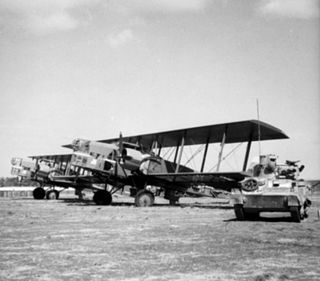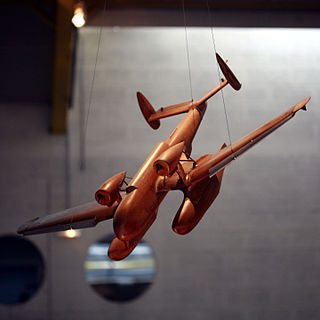
The Amiot 354 was the last in a series of fast, twin-engine bombers which fought with the French Air Force in limited numbers during the Battle of France.

The Bloch MB.130 and its derivatives were a series of French monoplane reconnaissance-bombers developed during the 1930s. They saw some limited action at the beginning of World War II but were obsolete by that time and suffered badly against the Luftwaffe. After the fall of France, a few were pressed into Luftwaffe service.

The Société des Avions Marcel Bloch was a French aircraft manufacturer of military and civilian aircraft. It was founded by the aeronautical designer Marcel Bloch, who had previously played a major role in the Société d'Études Aéronautiques, an early French aircraft manufacturer active largely during the First World War.

The Bloch MB.210 and MB.211 were the successors of the French Bloch MB.200 bomber developed by Société des Avions Marcel Bloch in the 1930s and differed primarily in being low wing monoplanes rather than high wing monoplanes.

The Bloch MB.170 and its derivatives were French reconnaissance bombers designed and built shortly before the Second World War. They were the best aircraft of this type available to the Armée de l'Air at the outbreak of the war, with speed, altitude and manoeuvrability that allowed them to evade interception by the German fighters. Although the aircraft could have been in service by 1937, debate over what role to give the aircraft delayed deliveries until 1940.

The Bloch MB.162 was a French four-engine, long-range bomber developed by Société des Avions Marcel Bloch in the late 1930s. Only a single prototype was built; after capture by German forces, it was pressed into service with the Luftwaffe as a transport.

The Potez 630 and its derivatives were a family of twin-engined, multirole aircraft developed for the French Air Force in the late 1930s. The design was a contemporary of the British Bristol Blenheim and the German Messerschmitt Bf 110.
The Bréguet 690 and its derivatives were a series of light twin-engine ground-attack aircraft that were used by the French Air Force in World War II. The aircraft was intended to be easy to maintain, forgiving to fly, and capable of 480 km/h (300 mph) at 4,000 m (13,000 ft). The type's sturdy construction was frequently demonstrated and the armament was effective. French rearmament began two years later than that in Britain and none of these aircraft were available in sufficient numbers to make a difference in 1940.

The Farman F.220 and its derivatives were thick-sectioned, high-winged, four engined monoplanes from Farman Aviation Works. Based on the push-pull configuration proven by the F.211, design started in August 1925 and the first flight of the prototype was on 26 May 1932. The largest bomber to serve in France between the two world wars was the final F.222 variant. One variation was intended to be an airliner.

Lioré-et-Olivier LeO 45 was a French medium bomber that was used during and after the Second World War. It had been designed for the new Armée de l'air as a modern medium bomber capable of performing independent strategic operations, unlike the majority of previous French bombers.
The PZL.48 Lampart (leopard) was a Polish heavy fighter-bomber design, that remained only a project, owing to the outbreak of World War II.
The Latécoère 611 was a French four-engined maritime reconnaissance flying boat of the Second World War. Although only a single prototype was completed, this served throughout the war, being used by both the Vichy French and Free French navies.

The Bréguet 730 was a French flying boat of the 1930s. Built to meet the requirements of the French Navy, it was ordered into production but no aircraft were delivered before France surrendered to Germany in June 1940. Four remaining incomplete airframes were completed after the end of World War II, serving with the French Navy until 1954.

The Lioré et Olivier LeO 25 was a bomber aircraft produced in France in the late 1920s.

The Loire-Nieuport 10 was a 1930s French prototype long-range maritime reconnaissance and combat floatplane produced by Loire-Nieuport, a joint venture between Loire Aviation and Nieuport-Delage. It was an attempt to answer the requirements for the Navy's programme Hydravion éclaireur de combat for a large floatplane capable of acting as a torpedo bomber or reconnaissance aircraft.
The Bréguet 482 was a French four-engined heavy bomber aircraft designed just prior to the outbreak of the Second World War with two prototypes nearing completion when Germany invaded France in 1940, one of which was flown after the end of the war as an experimental platform.
The Bloch MB.480 was a French twin-engined torpedo-bomber/reconnaissance floatplane designed just before the start of the Second World War by Société des Avions Marcel Bloch. Only two were built, the French Navy deciding to use landplanes instead.

The SNCAC NC.150 was a prototype French high-altitude bomber aircraft designed and flown just prior to the start of the Second World War. It was a twin-engined monoplane, with a third engine driving a supercharger. Although testing was promising, and orders were planned for a modified version as a back-up for the Lioré et Olivier LeO 45 and Amiot 354 bombers, the surrender of France in June 1940 ended development with only the single example being built.
The Dewoitine D.770 was a prototype French twin-engined attack aircraft of the late 1930s. It was intended as a replacement for the Breguet 693 but testing was incomplete by the time that France surrendered to Germany, and no production followed.

The SNCAC NC-600 was a prototype French twin-engined long-range fighter aircraft, developed by SNCAC from the earlier Hanriot H.220 fighter. The type never entered service, with development being ended by the French surrender in June 1940.














